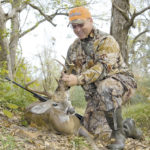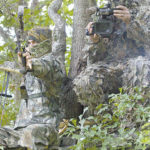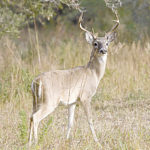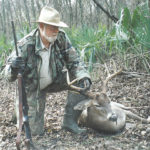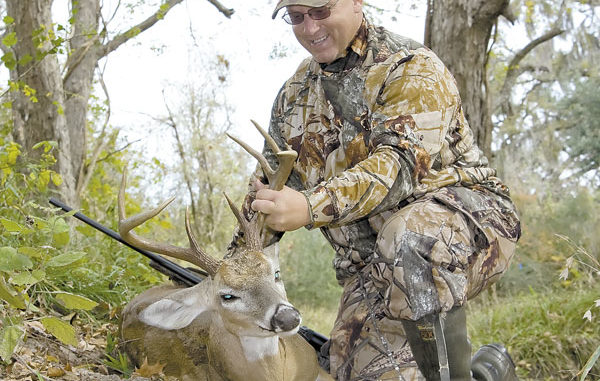
Think this year’s high water will force all mature deer up onto the ridges? Think again.
Water came early to Tensas Parish this year. Sloughs and drainage ditches that normally wouldn’t fill up until late December were already reaching their breaking points back in October. And deer that normally wouldn’t set hoof on a ridge that early had no choice but to leave the bottoms and head for the hills.“I can’t guarantee you anything,” said Mike Clement, who lives in West Monroe but owns property in Tensas Parish. “But these deer don’t have much choice right now. They would much rather be down in the bottoms, but they’re making do in my clover plots. We ought to have a good hunt.”
Clement’s invitation to hunt his private property near Buckhorn WMA proved to be the perfect opportunity for me to learn how he would hunt deer during December. In Tensas Parish, where there is so much farmland and not very many big patches of woods, understanding how and when deer utilize the low bottoms compared to the high ridges is instrumental to successfully shooting them.
“We got a bunch of drainage ditches and low areas that can’t be filled or farmed well,” said Clement, “and they get grown up in grass and weeds. Deer survive in these low spots all year long. Now during the summer, they get in the cotton and soybean fields, but as soon as those fields are harvested, they have no place to go but the low places that aren’t farmed.”
Not only do deer find cover and seclusion in the low spots, they also find lots of lush growth to eat. As the last bit of moisture dries from the sloughs and ditches, green browse grows in a ring around the water. Every time it dries a little more, the green browse spreads as the water gets lower and lower.
“In the summer and early fall, if you want pictures of bucks, you’ve got to put your cameras in the low, lush areas,” Clement said. “If you put it on the ridges and in the acorn flats, you won’t get pictures of anything but does.”
To drive home his point, Clement recalled that a year ago he was getting pictures of all kinds of big bucks after the season as they dropped their horns. Then, all of a sudden, they just completely disappeared. He waited for the sloughs on his property to start drying up and putting on new green growth, and then he moved his cameras.
“And there they were,” he chuckled. “I had hunted these low spots for years, but I never really knew what a magnet they were for deer until my cameras proved it to me. There were bucks in velvet on all my cameras, and the amazing thing was that it was entirely different groups of bucks on cameras as close as 150 yards to each other. I saw very little crossover.”
During normal years, Clement hunts these sloughs during the early bow season because he has no doubt that’s where the big bucks live. He can put his cameras 100 yards above the bottom of the sloughs and never get a single picture. But when he puts them directly in the bottom of the lowest spots, he gets pictures of big bucks every single night.
“I compare them to couch-potato people,” Clement said. “You can go in their yard and see where all they’ve been — tons of sign — but if you don’t go in there and open the door and look on their couch, then you’re not going to see them. They literally live that close together at the bottom of the sloughs and drainage ditches.”
When his sloughs and ditches are dry, as they should have been this past October, Clement hunts in permanent stands overlooking low spots that show the most deer sign. It takes a little bit of scouting to figure out which ones the deer use most frequently, but it’s not hard to see where deer have been eating on the green stuff, and the soft dirt at the bottom of the low spots shows the tracks of every deer that passes through.
Clement also pointed out that this is one of the few situations in Louisiana in which hunters could actually sneak up on deer. When the low spots are dry, walking the sloughs and ditches is easy and quiet.
“You can see a good distance, and you can ease through the sloughs while on the lookout for deer,” he added. “If there’s a deer down there, you can back up, get your wind right and ease down there and come out on him close enough to shoot. This is obviously more of a rifle thing, though. I typically stay in the stands if I’m bowhunting.”
After the low spots first fill with water, Clement moves from the low spots to his clover plots he has planted on the ridges. His clover was especially important this year as the sloughs and ditches filled in so early in the archery season. However, he hunts his clover patches only until the rut kicks into full gear. At that point, he actually returns to the bottoms.
John Rieger has hunted the sloughs of North Louisiana since he was old enough to hold his own rifle, and his travels while hunting and filming footage for the Field X-Tremers DVDs has taught him exactly why Clement returns to the bottoms during the rut.
“Does go to the water to get away from the bucks during the rut,” said Rieger. “Bucks chase does by scent, and the water helps to cover her scent if she doesn’t want a buck on her. When the rut kicks in, all the does will be in the bottoms trying to get away from the bucks, and all the bucks will be in the bottoms trying to breed the does.”
Another reason Rieger has found that sends big bucks to the water is hunting pressure. Not many hunters think about actually hunting water, and the pressure around the water can quickly drive them right out in it rather than on the edges of it.
“Those old smart bucks are out there in the water because they’re going to do what they can to stay from predators and humans,” Rieger said. “And I think once they move into the water, they don’t come up on land until maybe 10 or 11 at night to do whatever they want to do; then it’s right back to the swamps. You may get a picture of one at night and hunt him all season long, but you’ll never see him because he’s down in those deep bottoms.”
While Clement and Rieger have seen bucks actually lying down in the water, more often than not, Clement has discovered them lying right on the edge of the water rather than in it. In an attempt to have to only protect their front, deer around Clement’s low areas will bed with their backs to the water and their noses to the wind.
“They do that so nothing can come up on them without them knowing it,” Clement said. “They must not think anything’s going to come up on them from the water. I’ve killed some of the biggest deer of my life out of my HydraSport bass boat. They never look behind themselves, and the only way to get in on them is by boat.”
Although it is illegal in Louisiana nowadays to hunt deer out of a boat with a motor attached in operating position, Clement took some of the biggest bucks of his life with the help of his bass boat back when it was legal. Now he simply takes his position in a tree stand overlooking some kind of lane with a slough crossing it in the distance.
“You can sit there and watch does and bucks chasing each other back and forth through that water all day long,” Clement said. “All these Tensas hands know the bucks go to waist-deep water during the rut. You might not find but one doe in the water, but she’ll have three or four bucks chasing her.”
On the other hand, Rieger likes to find little islands, dams or levees that funnel deer that have taken to the water. And he says finding a hotspot is sometimes as simple as locating one of these kinds of areas with tracks running across it.
“If you find those tracks, you’re going to find deer,” Rieger said. “It’s hard to find much sign because of all the water, but if you can pinpoint some kind of trail going across these high spots in the water, set up on whatever side the wind is blowing, and get ready. He’s coming.”
Clement and Rieger admit that it’s difficult to make a decision to hunt the water when there are 20 deer in your food plot. The big bucks get off the clover and get in the bottoms, though, and that’s exactly where you need to be if you want to shoot one.
